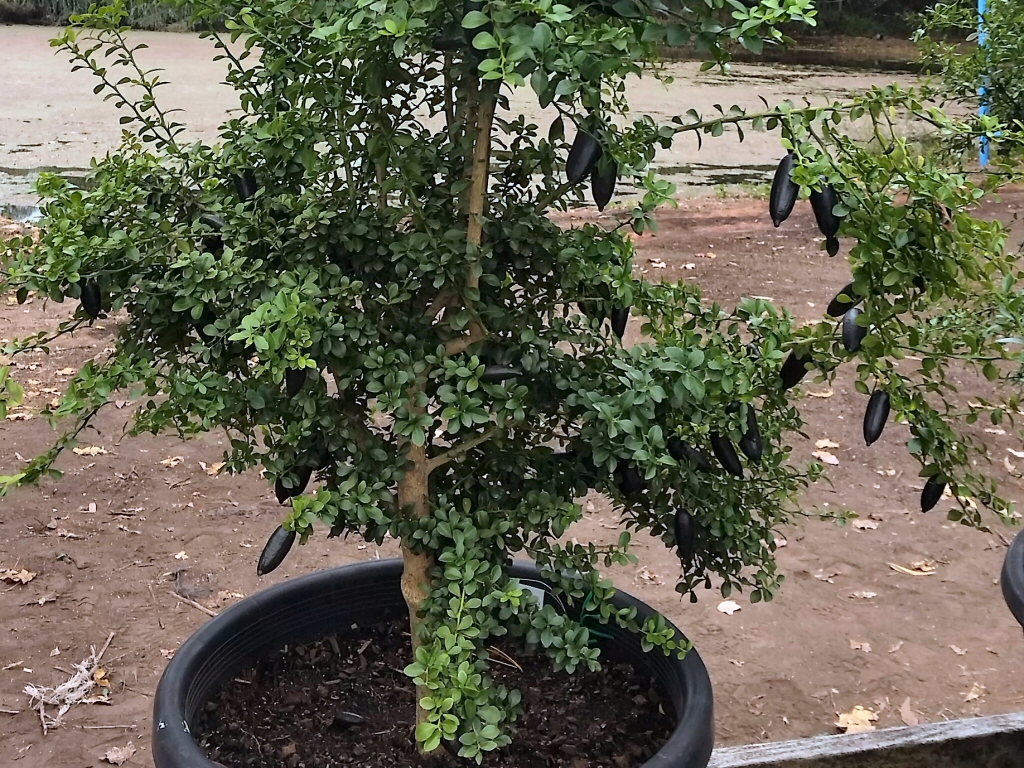People are discovering Australia’s own citrus, long neglected due to the small fruit and prickly nature. But once people started getting creative with the little pearls of citrus goodness inside the fruit, suddenly everyone wanted them! Delicious in seafood salads and gin & tonic, as a beautiful and tasty garnish, for sauces and marmalade, and to add eye appeal to your food.
How to grow Australian native finger limes
Citrus australasica naturally grows in rainforest areas of north east NSW and south east Queensland, but is adaptable to other areas with a small amount of care and attention. Best climate is frost free near the coast but they will take some frost if you are inland. The more sheltered a spot you can find in cold areas, the better for the plant. They also need good drainage, and a soil with a pH between 6 and 7.
They will grow in full sun but also in positions with dappled sun, thanks to their rainforest heritage. A soil rich in organic matter is appreciated, and mulching helps deter weed growth and keep the soil moist. Citrus dislikes competition form other plants, so it is best not to grow other plants beneath them or to grow them in a lawn.
Feeding can be done with any good fertiliser, ones formulated especially for citrus and other fruit work well. Regular doses of worm tea work well, well rotted manures are good too.
Commonly asked questions about native citrus
My finger limes drop fruit before it is ripe
This could be from a lack of pollinators for your tree. Try adding a second native citrus. If that doesn’t work then you may need to hand pollinate the flowers.
If pollination isn’t the issue, then there are a couple of other issues that can cause premature fruit drop. If the tree is stressed during fruit formation they will drop off. This could be most likely water or nutrient stress. Try a more regular watering schedule, and supplementing the plant with a good fertiliser formulated for fruiting plants, or for citrus. Boron deficiency can also cause fruit drop, so a trace element fertiliser could be worth a try.
Can native citrus grow in pots
They will grow well in pots, the bigger the pot, the better. Care for your native lime as for any citrus – regular water and feeding is a must!
Are native citrus frost hardy
Frosty climates are not ideal but if you could grow it in a pot in a protected spot you have a vey good chance of getting fruit. I have seen it work like this in Canberra. Protected spots are near brick walls and areas of concrete, as these will heat up during the day and radiate some warmth back at night. Walls also give some wind protection too. If you do get a very frosty night, then watering before the sun hits the plant will help melt some of the ice formation.
How suitable are native citrus for semi arid areas with mild frosts?
Choose an area with some protection, and add organic matter to your planting spot, and mulch to retain as much moisture as possible. You should also consider the Australian desert lime which is very frost tolerant, if you can get it. It is similar to finger lime but with rounded fruits.
How are finger limes propagated
They can be grown from seed, though seedlings can take up to fifteen years to produce fruit. They can be grown from cuttings, and also grafted. Grafting reduces the time taken for a plant to fruit.
What pests and diseases do finger limes get
They will get similar problems that normal citrus suffer. Gall wasps can lead to loss of production, and manifests as lumps on the stems….prune off affected foliage and burn or bin. Scale, stink bugs, caterpillars, leaf miner, leaf hoppers and mealy bug can affect your plant, white or eco oil are the best option to deal with them, and if they persist, ask your nursery what they recommend. My favourite method of dealing with stink bugs is to use long handled tongs (with eye and skin protection as the bugs squirt corrosive liquid) and then drop them into a bucket of water with a squirt of dish washing liquid added. They quickly drown. A plant that does not get enough soil drainage can develop root rotting diseases, so be sure to plant in a well drained spot, building up your soil to a raised bad if necessary. A hungry plant will be more susceptible to problems, so feed regularly.
What is the best fertiliser for native citrus?
Commercial fertilisers work for finger limes, ones made specifically for citrus and fruit are best. Natural feeding with worm tea and well rotted manures are excellent.



